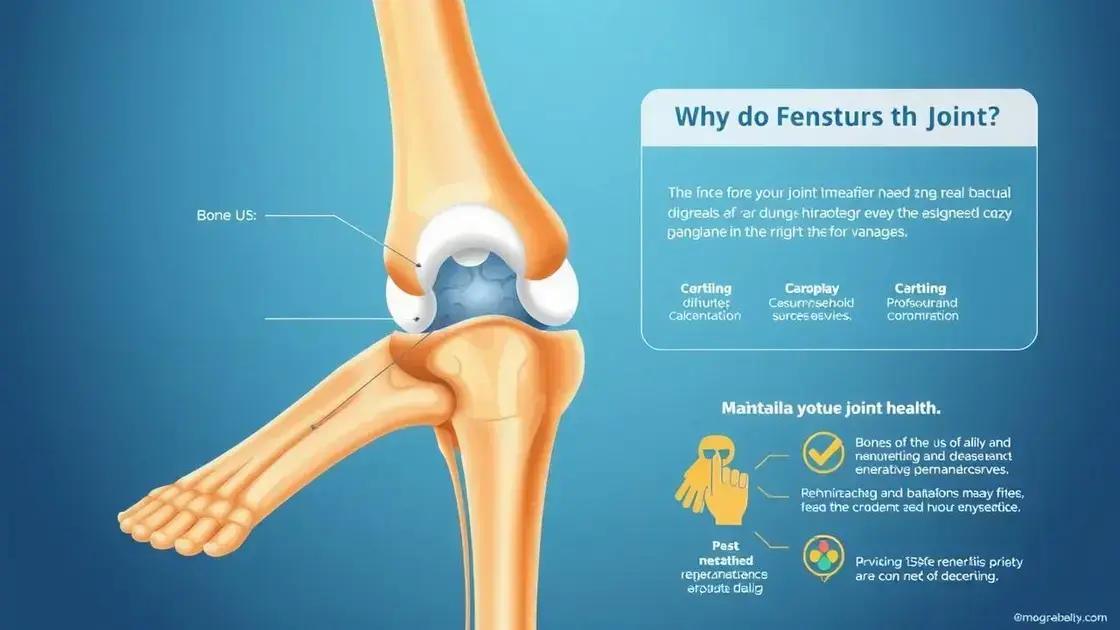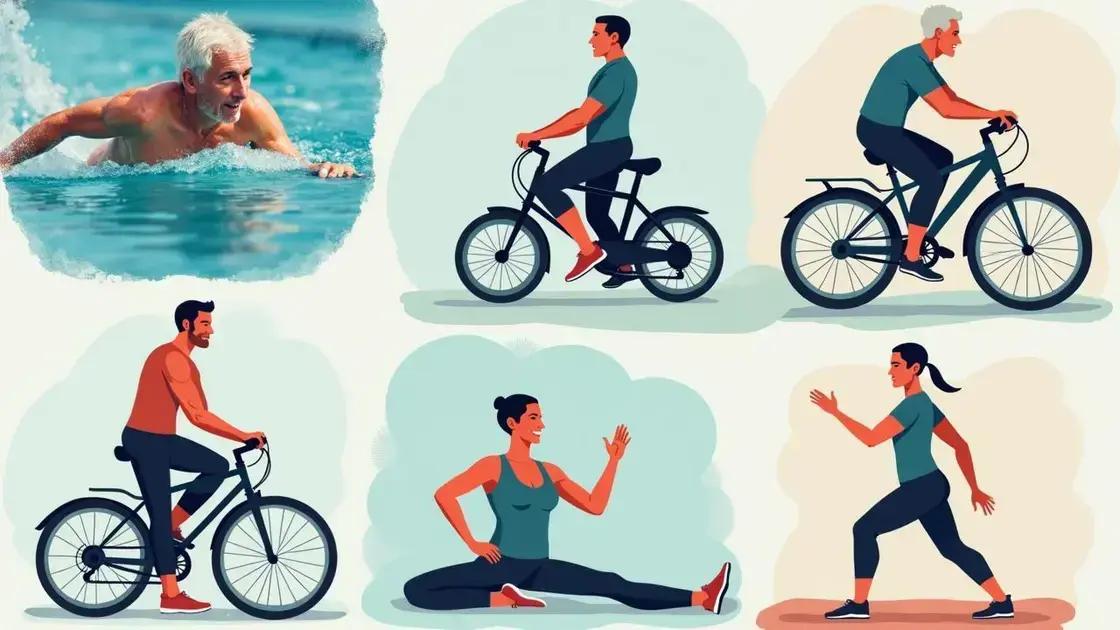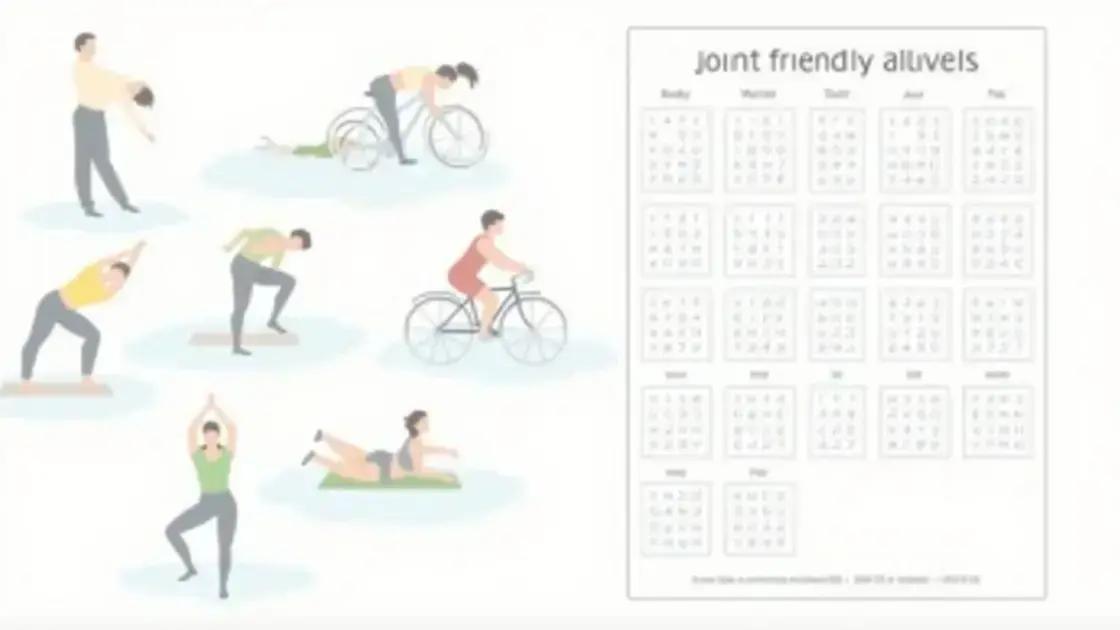To protect your joints, incorporate low-impact exercises like swimming, cycling, and yoga into your routine. These activities strengthen muscles, improve flexibility, and reduce the risk of injury, promoting overall joint health.
Protecting your joints is essential for maintaining a healthy and active lifestyle. Low-impact exercises can help keep your joints safe while still providing the benefits of physical activity. In this article, we will explore how to protect your joints with low-impact exercises that are easy to incorporate into your daily routine. You will learn about the significance of joint health, the benefits of opting for low-impact workouts, and how to create an effective routine tailored to your needs.
Understanding Joint Health

Joint health is crucial for maintaining mobility and overall quality of life. Joints are the connections between bones, allowing for movement and flexibility. Healthy joints can help prevent pain and discomfort, especially as we age or engage in physical activities.
What are Joints?
Joints are made up of two or more bones that come together to provide stability and support while enabling movement. Each joint is surrounded by cartilage, a smooth tissue that cushions and protects the bones from rubbing against each other.
Factors Affecting Joint Health
Several factors can impact joint health, including age, genetics, weight, and activity levels. As we get older, cartilage can wear down, leading to problems like osteoarthritis. Maintaining a healthy weight is also vital, as excess weight puts additional stress on your joints.
Signs of Joint Issues
Common signs of joint problems include swelling, stiffness, and pain during movement. If you experience these symptoms regularly, it may be time to consult a healthcare professional. They can provide guidance on how to protect your joints and improve your overall joint health.
Importance of Exercise for Joints
Regular exercise is essential for joint health. Low-impact exercises, in particular, can strengthen the muscles around the joints and improve flexibility without causing additional strain. This can enhance stability and reduce the risks of injuries.
Benefits of Low-Impact Exercises

Low-impact exercises offer many benefits for both physical and mental health. These exercises are gentle on your joints while still providing effective workouts. They help you stay active without causing excess strain on sensitive areas.
Improved Joint Health
By engaging in low-impact exercises, you can strengthen surrounding muscles and improve flexibility without overloading your joints. This support helps reduce the risk of injury.
Enhanced Cardiovascular Fitness
Low-impact exercises like swimming and cycling still provide great cardiovascular benefits. These activities can increase your heart rate and enhance circulation, contributing to better overall heart health.
Increased Strength and Balance
Many low-impact exercises focus on building core strength and improving balance. This is especially beneficial for older adults who may face challenges with stability.
Low Risk of Injury
Since low-impact exercises minimize stress on the body, there is a decreased risk of injuries. This makes them an excellent choice for beginners, older adults, or anyone recovering from an injury.
Stress Relief and Mental Clarity
Engaging in physical activity releases endorphins, helping to reduce stress and improve mood. Low-impact exercises can also promote mindfulness and relaxation.
Top Low-Impact Workouts

Low-impact workouts are an excellent way to stay fit while protecting your joints. Here are some of the top exercises you can explore:
Swimming
Swimming is a fantastic full-body workout. The buoyancy of the water reduces stress on joints while providing resistance to help build strength. Try different strokes to engage different muscle groups.
Cycling
Cycling, whether on a stationary bike or outdoors, is great for cardiovascular fitness and leg strength. It’s easy on the joints and can be done at various intensities.
Yoga
Yoga is perfect for improving flexibility and balance. Many poses can be modified for all fitness levels, making it accessible while enhancing joint mobility.
Pilates
Pilates focuses on core strength and stability. These exercises are low-impact and can help improve posture and strengthen the muscles around your joints.
Walking
Walking is the simplest low-impact exercise. It can be done anywhere and is perfect for all fitness levels. Aim for a brisk pace to get your heart rate up while being gentle on your joints.
Water Aerobics
Water aerobics combines aerobic exercise with the resistance of water. It’s effective for building strength and endurance without stressing your joints, making it ideal for all ages.
Creating a Joint-Friendly Routine

Creating a joint-friendly routine is essential for maintaining health and mobility. Here are some tips to help you build a safe and effective routine:
1. Start Slowly
If you’re new to exercise or returning after a break, ease into your routine. Start with shorter workouts and gradually increase duration and intensity over time to prevent injury.
2. Incorporate Variety
To keep your routine interesting and balanced, combine different low-impact exercises. Mix swimming, cycling, yoga, and walking to engage different muscle groups and avoid overtraining.
3. Prioritize Warm-Ups and Cool-Downs
Always begin your workouts with warming up your muscles and joints. Stretching can improve flexibility and reduce potential injuries. Likewise, cool down after exercising to help your body recover.
4. Listen to Your Body
Pay attention to how your body feels during and after exercise. If you experience pain or discomfort, adjust your routine as needed. It’s essential to differentiate between normal fatigue and potential injury signals.
5. Stay Consistent
Aim for regular exercise, ideally 3-5 times a week. Consistency enhances the benefits of low-impact workouts while helping to develop a long-term fitness habit.
6. Consult a Professional
If you have existing joint issues or concerns, speak with a healthcare provider or a certified trainer. They can customize a routine to suit your needs and ensure you’re exercising safely.
Summing Up the Importance of Joint Health
Protecting your joints is essential for maintaining mobility and ensuring a high quality of life. By engaging in low-impact exercises, you can enhance your joint health while enjoying various physical activities.
Understanding joint health and the benefits of low-impact workouts empowers you to create a sustainable, joint-friendly routine. Incorporating exercises like swimming, cycling, yoga, and walking can improve your strength, flexibility, and overall well-being.
Remember to start slowly, listen to your body, and stay consistent with your exercise regime. With these strategies, you can enjoy an active lifestyle while safeguarding your joints against injury and long-term damage.
Make joint health a priority and embrace the joys of movement with the right approaches to low-impact exercises!
FAQ – Frequently Asked Questions about Protecting Your Joints with Low-Impact Exercises
What are low-impact exercises?
Low-impact exercises are physical activities that put less stress on your joints while still providing a great workout. Examples include swimming, cycling, and yoga.
How do low-impact exercises benefit joint health?
They strengthen the muscles around the joints, improve flexibility, reduce stiffness, and lower the risk of injury while still enhancing overall physical fitness.
Can anyone do low-impact exercises?
Yes, low-impact exercises are suitable for people of all ages and fitness levels. They are especially beneficial for those recovering from injuries or with existing joint issues.
How often should I include low-impact exercises in my routine?
Aim for 3-5 sessions per week, making sure to incorporate variety to keep your workouts engaging and effective.
What should I do if I experience pain while exercising?
If you feel pain, stop the activity immediately and assess your discomfort. Consult a healthcare provider if the pain persists or you have concerns about injury.
Are warm-ups really necessary for low-impact exercises?
Absolutely! Warm-ups prepare your muscles and joints for exercise, reduce the risk of injury, and improve overall performance.












